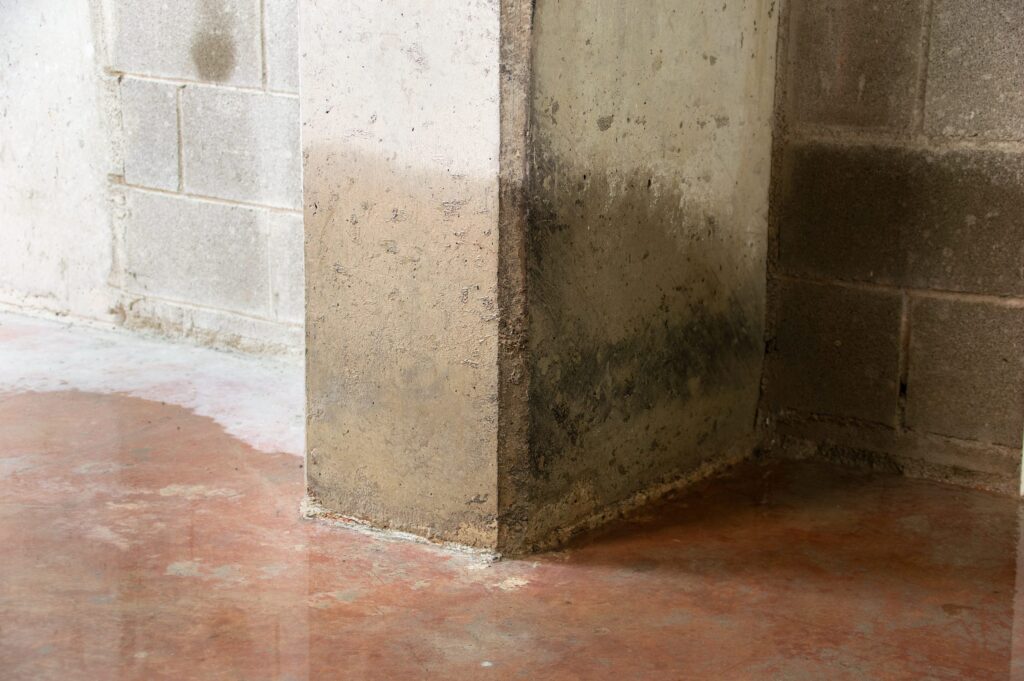Using proper basement waterproofing methods for your interior is a proactive way to prevent water damage and protect your home. Whether you have an unfinished basement, a finished one, or crawlspace, maintaining a dry environment is essential.
We recommend using these three methods together to keep your basement interior as protected as possible. Most people would not want to find a swimming pool spontaneously appear in their basement, and we assume you don’t either.
Before we cover these three waterproofing methods, let’s go over some basics:
Why You Should Waterproof Your Basement Interior
Because the basement is built into your home’s foundation, keeping water out can safeguard your living space against severe and costly complications later on. Furthermore, you may have expensive appliances or are storing valuable items downstairs. Why risk having to replace them due to a leak?
Let’s also not forget another danger related to wet basements: mold. Mold spores pose a serious health hazard and should never be taken lightly.
What Tools Do You Need to Waterproof a Basement?
There are a variety of tools you can use to prevent basement moisture, from dehumidifiers to sealants, drainage systems, and more. The ones you need for your walls will depend on your specific situation.
Method 1: Sealing Cracks and Holes
Cracks and holes in the basement walls are common entry points for water. Periodically checking your walls for these will allow you to address the issue before they grow larger.
You can remedy this problem by filling a crack or hole with a special sealant that is designed to both close the opening and prevent water from re-entering. Before applying the sealant, though, be sure you clean your basement walls first.
What is the Best Sealant for Interior Basement Waterproofing?
We recommend a sealant like DRYLOK for waterproofing your basement interior. There are a few varieties to match both unfinished and finished basements to stop water intrusion and prevent future issues for the long haul.
To properly apply sealant:
- Clean your wall
- Remove sealant from container with a brush or trowel
- Make sure the sealant has filled the crack or hole appropriately
- Use your tool of choice to ensure the sealant is smooth against the surface of the wall
- Once dry, leave as-is or paint over the sealant patch to match the rest of your wall
Method 2: Reroute Water Away from Your Foundation
While there are interior methods for waterproofing your basement, water damage usually stems from an exterior issue. Oftentimes, water seeps into the foundation which creates the cracks or holes that you ultimately patch up from the inside.
How Can I Tell if There is an Exterior Cause for Basement Leaks?
Look around your property for some key indicators:
- Is there a gutter not properly irrigating water away from your house?
- Is there an opening between pavement and your foundation?
- Is there an inward slope bringing water into your house from dirt or pavement?
- Are your basement windows properly sealed?
If you find an external cause of water entry, be sure to correct it quickly. You can either do so yourself or contact a professional to help you.
Method 3: Waterproof Your Basement with Drainage Systems
Are you concerned with keeping your basement dry on a consistent basis? In that case, you may want to consider installing a sump pump or French drain system. These will allow you to quickly address flooding issues.
Though you can install most sump pumps yourself, professionals can also assist in this as well. Most systems are easy to use and will completely drain the basement of all present water.
Methods for Waterproofing Your Basement Crawlspace
Due to their smaller, tighter area, crawlspaces present unique challenges different from full-sized basements.
Wet crawlspaces are a time-consuming and difficult issue to remediate. Rather than having to deal with them in the first place, though, preventing moisture is the best course of action.
To prevent moisture in a crawlspace, consider the following two options:
Vapor Barriers: Installing a vapor barrier blocks moisture in your crawlspace from spreading to the rest of your home. This will aid in both containing water damage and preventing mold in the future.
Dehumidifier: Dehumidifiers will reduce the humidity levels in your crawlspace to help keep it dry on a recurring basis. Installing one is easy to do and they are available in a variety of sizes and price points.
Need to Find the Best Basement Waterproofing Method for You? Let’s Talk.
Determining the right waterproofing solution for your specific situation is not always black and white. Sometimes, it seems like the water problem is appearing out of thin air.
The DryTek team specializes in identifying and solving water damage-related issues for all building types. To speak with one of our experts, contact us anytime.


